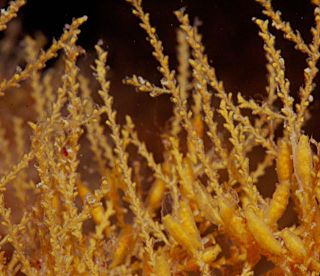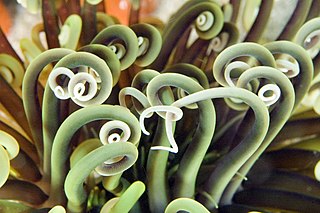
Tube-dwelling anemones or ceriantharians look very similar to sea anemones but belong to an entirely different class of anthozoans. They are solitary, living buried in soft sediments. Tube anemones live inside and can withdraw into tubes, which are composed of a fibrous material made from secreted mucus and threads of nematocyst-like organelles known as ptychocysts. Within the tubes of these ceriantharians, more than one polyp is present, which is an exceptional trait because species that create tube systems usually contain only one polyp per tube. Ceriantharians were formerly classified in the taxon Ceriantipatharia along with the black corals but have since been moved to their own class, Ceriantharia.

Plaxiphora is a genus of chitons in the family Mopaliidae. It is distributed in the Atlantic, Indian, and Pacific Oceans, primarily in the south-temperate and subantarctic regions.

Acanthochitona is a genus of chitons in the family Acanthochitonidae, of worldwide distribution.

Notoplax is a genus of chitons in the family Acanthochitonidae.

Cryptoplax is a genus of polyplacophoran molluscs. The genus consists of the following living species:
Entonomenia is a genus of cavibelonian solenogasters, shell-less, worm-like mollusks.
Paragymnomenia is a genus of cavibelonian solenogasters, shell-less, worm-like, marinemollusks.

Sertularella is a genus of hydroids in the family Sertulariidae.

The Diphyidae are a family of siphonophores. These are colonial siphonophores with two nectophores arranged one behind the other. The front one includes a somatocyst, while the hind one does not. The somatocyst often contains an oil droplet for buoyancy control. A nectosac in each nectophore allows the organism to swim efficiently.

Cerianthidae is a family of tube-dwelling anemones in the order Spirularia of the subclass Ceriantharia.
Paraperipatus is a genus of velvet worms in the family Peripatopsidae. The number of legs vary within species as well as among species in this genus and can range from as few as 21 pairs up to 27 pairs in males and 29 pairs in females. The maximum number of leg pairs recorded in this genus (29) is also the maximum number of leg pairs found in the family Peripatopsidae. This genus exhibits matrotrophic viviparity, that is, mothers in this genus retain eggs in their uteri and supply nourishment to their embryos, but without any placenta. Species in this genus are found in New Guinea and Maluku, Indonesia.
Anthoactis is a genus of cnidarians belonging to the family Cerianthidae.
Isodactylactis is a genus of cnidarians belonging to the family Cerianthidae.
Hensenanthula is a genus of cnidarians belonging to the family Botrucnidiferidae.
Bursanthus is a genus of cnidarians belonging to the family Cerianthidae.
Botrucnidiata is a genus of cnidarians belonging to the family Botrucnidiferidae.
Gymnanthula is a genus of cnidarians belonging to the family Botrucnidiferidae.
Atractanthula is a genus of cnidarians belonging to the family Botrucnidiferidae.
Cerianthula is a genus of cnidarians belonging to the family Botrucnidiferidae.
Botrucnidiferidae is a family of cnidarians belonging to the order Spirularia.








